Ridge Vineyards is a legendary vineyard in California. Their winemaker Paul Draper is also a legend in the wine world. Ridge was among the first to show the way towards quality wines in California. Paul Draper came to Stockholm to present his wines and to lead a vertical tasting of their prestige wine Ridge Monte Bello, plus several other wines. BKWine’s Magnus Reuterdahl reports.
Some time ago, the legendary winemaker Paul Draper of Ridge Vineyards, California, USA, was in Stockholm to show his wines, together with the importer Vinunic.
Ridge: the eye-opener
Ridge was one of the first wines I drank that really was a revelation, an eye-opener. This was sometime around 1995. Since then I have bought a few bottles every year with the exception of a few years in the early 2000s, when I was studying.

My first Ridge was a Geyserville, an excellent wine made from zinfandel. I’ll admit that I was a little sceptical when I bought it because I had already learned that many zinfandel wines were a little too much warm fruit, almost jammy, sweet, a little too oaky and had a little too much alcohol. Geyserville is something entirely different, something playful, elegant and complex with a relatively low alcohol content, And it ages well.
This is what Paul Draper says:
I’m a cabernet fan, but what do I drink on a daily basis? I’m drinking zinfandel. A young, hard cabernet is not sensuous, not delicious. A young zinfandel is.
I am inclined to agree with Paul Draper, at least when it comes to young wines and if they keep the same quality as does his. Paul Draper has been the winemaker at Ridge since 1969.
More European than the Europeans?
He describes himself as a humanist and philosopher rather than a winemaker. He also has a degree in philosophy from Stanford University. This is something that seems to come through in the wines, there is more feeling than construction in them.
In addition, he is charming, friendly and clever, and this too are qualities that I think you can find in his wines. The wines can, in short, be described as a bit more European than most European wines.
Natural without being a “natural wine”
The Ridge wines are made in a “natural” way but they are not “natural wines”. They use methods that many natural wine makers use, with for example as little additives as possible, to make the terroir speak for itself.
If you compare the grape blends in the wines below you will see that they change a lot from the year to create the best wine for that year based on each year’s qualities. From next year they will also be labelling with a table of contents to show us exactly what we drink.

For Ridge and for Draper it is also important that the wines should be accessible. In other words, they try and price the wines reasonably so that wine lovers will be able to enjoy them. If I think back they actually cost more or less as much, or as little, now as when I started buying them in the mid-90s. So one can say that they actually dropped slightly in price over time.
How does the Ridge Vineyard’s wines taste?
Enough about that and on to the tasting!
Ridge Estate Chardonnay 2011
100% chardonnay. A stylish chardonnay that can honourably fight with almost anything from Burgundy in its class. The flavour has hints of yellow apple, exotic fruit and a hint of citrus. The wine is elegant, balanced and wonderful, with fine acidity and a good volume (“fat”). Still a bit young, with the oak a bit “on the outside”. Keep it for some time and then enjoy.
Ridge Lytton Springs 2011
82% zinfandel, 16% petite sirah, 2% carignan. This is a charming wine, with red berries, blueberries and some cherries and a spicy aftertaste. Perhaps a bit of a “party wine” and perhaps a little one-dimensional in comparison with its brothers and sisters. But very good.
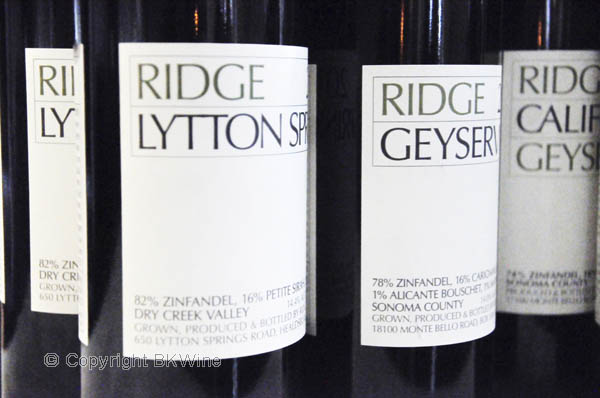
Ridge Geyserville 2011 and 2001
The first is a blend of 78% zinfandel, 16% carignan (often spelled “carignane” in California), 4% petite sirah, 1% alicante bouschet and 1% mataro (mourvedre). The second is a blend of zinfandel, carignan, and petite sirah. These wines show the potential of Geyserville if you want to keep and age them. I always buy a few bottles for now (to be drunk within a few years) and save a few for the future (approximately 7-10 years).
The 2011 is a little young but will be great. The fruit is dense and concentrated with notes of cherry, blueberry and blackberry and a slight hint of violet. The oak is balanced and there are distinct tannins. Perfect for the barbecue next summer.
The 2001 is a bit on the limit in terms of age. If you have some left in your cellar I think it is time to uncork them. It is not bad but there is a risk that it starts dropping off within a few years. The flavour is developed with a little leather and tobacco notes, the fruit is soft and there are a lot of candy tones that goes towards toffee and raspberry candy and a little in the liqueur direction with a slightly earthy finish. I have one or two bottles left and they will be finished this autumn!
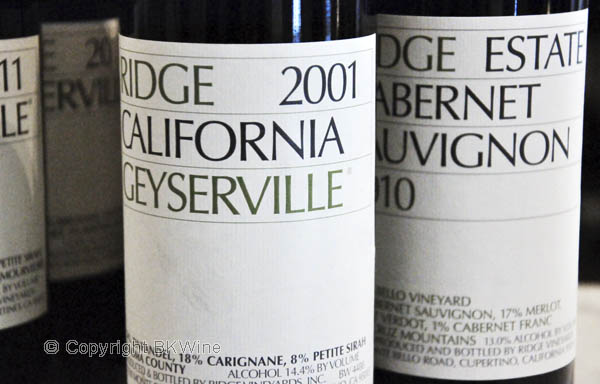
Ridge Estate Cabernet Sauvignon 2010
It is a bit like a “Monte Bello light”. This is simply a really good bordeaux-blend made of 80% cabernet sauvignon, 17% merlot, petit verdot 2% and 1% cabernet franc. Somewhat sweetish full-bodied flavour with hints of black currant, coffee and elegant acid. Not particularly complex, straightforward, but to the point and well made. Perfect with lamb or beef.
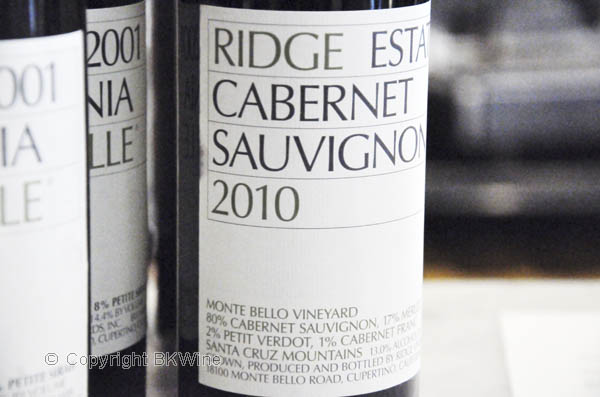
Monte Bello, 2012, 2011, 2009, 2006, 2005, 2004…
Finally, the main event, a vertical of Monte Bello. It was served vintages:
- 2012: barrel sample, 62% cabernet sauvignon, 22% merlot, 9% cabernet franc and petit verdot 7%
- 2011: 87% cabernet Sauvignon, 9% Merlot, 4% cabernet franc
- 2009: 72% cabernet sauvignon, 22% merlot, 6% petit verdot
- 2006: 68% cabernet sauvignon, 20% merlot, 10% petit verdot, 2% cabernet franc
- 2005: 70% cabernet sauvignon, 22% merlot, 6% petit verdot, 2% cabernet franc, and
- 2004: 51% cabernet sauvignon, 47% merlot, petit verdot 1%, 1% cabernet franc
Unfortunately, the last one was corked but I managed to nick a small sample from a correct bottle from a colleague.
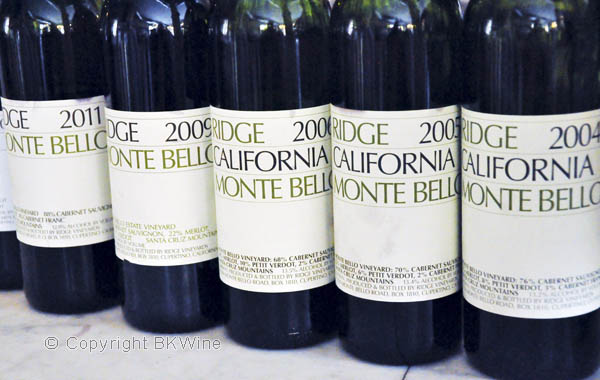
2005 is my favourite. It is still too young, but it is getting closer with a little maturity starting to creep into it and you can imagine what it will become. Brilliant.
2006 is perhaps the easiest to drink right now. It is a little warmer in tone, which makes it a little easier to taste. But it had a short life in the glass.
2009 and 2011 are much too young, but certainly there is greatness under the fruit just waiting to pop out. Especially the 2009 feels like a real top vintage.
2012 is a barrel sample and difficult to judge. The fruit tastes like freshly crushed berries and it becomes almost like a young calf on pasture. There is something new all the time that demands one’s attention. But there are a bit too many things all at once. Time will tell where this vintage will go.
My sample of the 2004 was corked but the second sample I tried felt quite weak in comparison to the others.
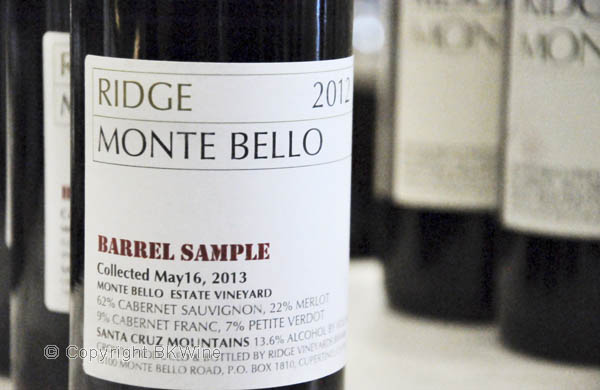
Common to all Monte Bello wines is an elegance mixed with concentrated dense fruit that drives the wine forward, held together by a sprightly acidity and perfectly balanced oak. A spiciness that goes from flowery to herbaceous medicinal, with splashes of grass and minerals. The fruit is black and red currants and blackberries and traces of dark plums and cherries. All this is backed by minerality and a hint of liquorice, a fresh earthiness and stylish tannins. I can continue for a while, but to make it simple, this is really good. This is really good!
Ridge actually makes more wines than the ones we got to taste:
The cabernet sauvignons are Monte Bello and Estate Carbernet.
The chardonnays are Monte Bello Estate chardonnay, Jimsomare and Mikulaco.
The merlots are Estate Merlot and Torre.
The petite sirahs made are Lytton Estate and Dynamite Hill.
From zinfandel they make Buchignani, Carmichael, Mazzoni, East Bench Geyserville, Lytton Springs, Pagani, Paso Robles, Ponzo, Three Valleys, York Creek, Lytton Estate and Dusi.
They also make a series called Rhones: Carignan, Grenache, Syrah and Syrah-Grenache.
Of the 27 wines are 5 available in Sweden. Most of these wines are made, however, in small batches so that they never be very common to see on the export market. I would, above all, love to try some from the Rhones-series!
Magnus Reuterdahl writes on wine on BKWine Magazine and is an avid wine blogger. You can read more of his thoughts on Magnus Reuterdahls wine blog, or follow him on twitter where he goes by @reuterdahl. In daily life Magnus is an archaeologist.
[box type=”info” style=”rounded” border=”full”]California is one of the few of the major wine regions that BKWine does not organize wine tours to, except of course customized wine tours. Many of the other of the world’s great wine regions you can travel to on a wine tour with BKWine. Go on a wine tour with the experts on wine and with the wine tour specialist![/box]










4 Responses
Hi Magnus,
Great write-up. I’m a Ridge virgin but hopefully I’ll get the chance to try them some day.
This phrase stuck in my craw a bit though:
“The Ridge wines are made in a “natural” way but they are not “natural wines”.”
Whilst I understand the sentiment, this is patently ridiculous – and just goes to show how problematic the term has become. Isn’t the sub-text then “natural wines are crazy/taste weird/might be faulty”? I think it’s a shame that “natural wine” has become a term that winemakers (or writers?) are scared of – even though I admit I’m the same, I avoid it like the plague in most cases, because it can be so
In my opinion it would be better just to say the wines are made with minimal intervention (or “in a natural way” if you must) and leave it at that. Otherwise it’s a bit like saying “this wine is fermented in oak barrels but it’s not an oaked wine”.
I also was interested whether this was Paul Draper’s comment, or your analysis?
Look forward to seeing you in Sicily soon,
Simon.
Hi Simon
Thanks -and you should do something to pop that cherry ;)
I agree with you; minimal intervention would be a better way to phrase it – regarding Paul Draper’s comment it’s my analysis or perhaps summery of what he said – I don’t remember his exact words but they were something in that neighborhood.
See you on Sicliy – just a few weeks away now :)
Magnus